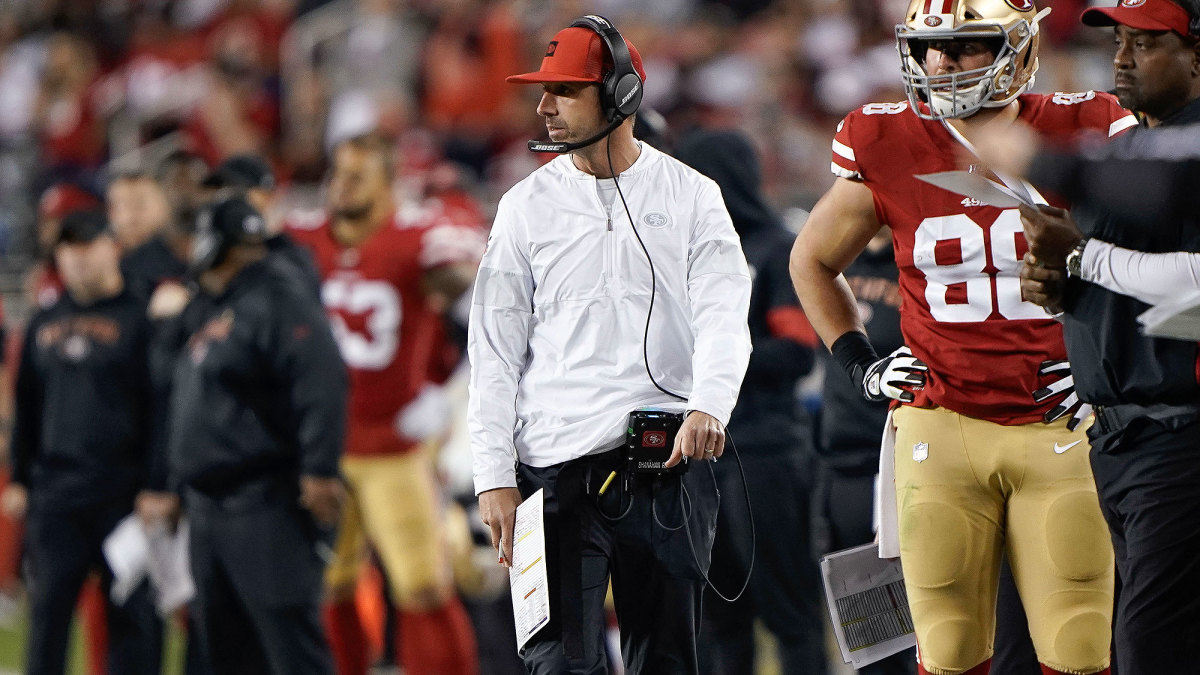What Makes Kyle Shanahan’s Offense So Dangerous and Effective?

The Kyle Shanahan score-score-and-score-some-more philosophy starts with some central tenets: collect fast, athletic players and find space for them to operate; then run the ball to assert dominance, control the clock and keep defenses honest, opening more space. Shanahan loves to run the outside zone. He majors on play-action passes, and he wants to make those concepts look similar before changing which players go where and how wide they split out.
He also knows specifically what he wants at each position. Take offensive linemen, for instance—Shanahan prefers lighter ones who are more athletic, because he asks them to move laterally more than most coaches. When he arrived in Atlanta in 2015 as the offensive coordinator, he cut every lineman who didn’t fit that prototype, all but two.

When it comes to running backs, Shanahan had long been enamored with Michael Bennett, a speedy, shifty back who could catch passes and hit holes for long gains in Tampa Bay. When Shanahan took over complete roster control in San Francisco, he decided to find some Bennett clones, only faster, so that they could speed through the spaces he created. Instead of signing one back like that, he found four, each with sub-4.4 speed in the 40-yard dash—he effectively created the NFL’s closest thing to a 4x100 Olympic relay team.
“There are probably 10 of those guys in the league,” says Mike McDaniel, the 49ers run game coordinator, “and we have four of them.”
From there, Shanahan builds a menu of plays with endless variations; the same bunch formation could yield dozens of options, based on which players stand where in the bunch and what their strengths are compared to the weaknesses of individual defenders. That will dictate which routes they run or how they block; it’s all very specific. The overall menu doesn’t change a ton over the course of a season, but what he chooses for any given week varies greatly. Players say they do a roughly 60% install of plays every single week.
Sometimes, the specificity surprises even Shanahan’s own players. On the Wednesday before a game in December 2018 against the Broncos, Shanahan drew up a pass play to George Kittle that wasn’t in the playbook.
“Look,” he told his tight end, “We’re going to run this play a couple times, and then we’re going to come back with this play-action, and as long as you don’t trip and fall, you’re going to have an 80-yard touchdown.“
Shanahan wasn’t exactly right. Kittle nabbed an 85-yard score, and as he ran downfield, with nothing but open space in front of him, he glanced over at the sideline. Shanahan was smiling. This, Kittle says, happens often enough to make it remarkable, as Shanahan scribbles red ink all over the plays that he’s installing until his white board looks lifted from the movie A Beautiful Mind.
“He’s right like nine out of 10 times,” Kittle says.
Shanahan is also adaptable. The 49ers won a game this season 9-0 (Washington, Week 7) and another 48-46 (New Orleans, Week 11). Shanahan tasked quarterback Jimmy Garoppolo with only 19 attempts in a divisional round playoff victory over Minnesota; that seemed like a shootout compared to the next week, when Garoppolo registered only eight attempts in the NFC title triumph over Green Bay.
There’s a play from that victory against the Packers that encapsulates Shanahan’s entire approach. And Sage Rosenfels, the retired NFL quarterback who played his best football in 2007-08 under a young Kyle Shanahan in Houston, settles in front of a television in a Miami hotel five days before the Super Bowl to show just how. His iPad sits in front of him, connected to the TV and one of those tiny remotes that football coaches use to rewind plays over and over again.
He stops at one play in the first quarter, on the 49ers very first drive. They’ve already moved the ball to the Packers 36-yard-line, but they’re facing an obvious passing down, a third-and-eight. “I imagine they designed this play just for this look,” Rosenfels says.
He points out the formation, with three receivers bunched closely to the right of Garoppolo, with Kittle split left but also close to the line. What looks like four receiving targets is actually part of the trick, a sleight of hand. They’re all lined up close, and their goal, once the play starts will be to open gaps.
Rosenfels hits play. Garoppolo takes the snap in shotgun, then quickly hands the ball to Raheem Mostert, one of the sprinter backs the 49ers have collected. Two important blocks happen right away, and they’re performed by the lighter, more athletic linemen that Shanahan always seeks. His left tackle, Joe Staley, moves immediately up field, but not before knocking a defender to the ground with a quick swim move. The space created by the fall allows his left guard, Laken Tomlinson, to seal the hole that Staley opened; Tomlinson walls off two defenders to his left, including the one who stumbled. The 49ers have essentially blocked three defenders with two players.
Mostert hits the hole without any sideways movement. “This is where their speed is just different,” Rosenfels says. “You think you can stop him. But he’s just going to out-run you.”
Kittle, a tight end who celebrates his blocks, seals another defender near the left sideline. Mostert outruns a corner and a safety for a 36-yard score—on an inside trap on third-and-eight.
“Classic Shanahan,” Rosenfels says. “If you have that kind of speed, if you can run it every play, if you can open gaps like that … why would you ever throw?”
Question or comment? Email us at talkback@themmqb.com.
